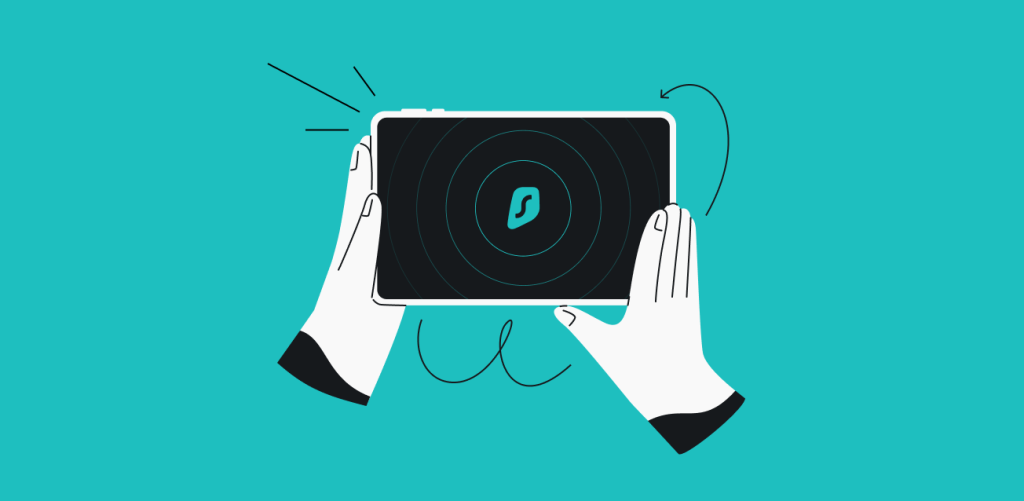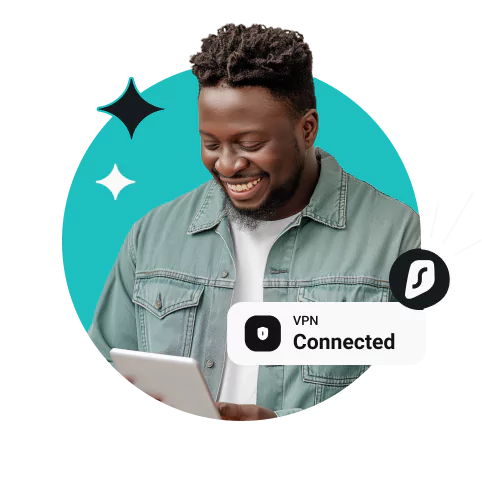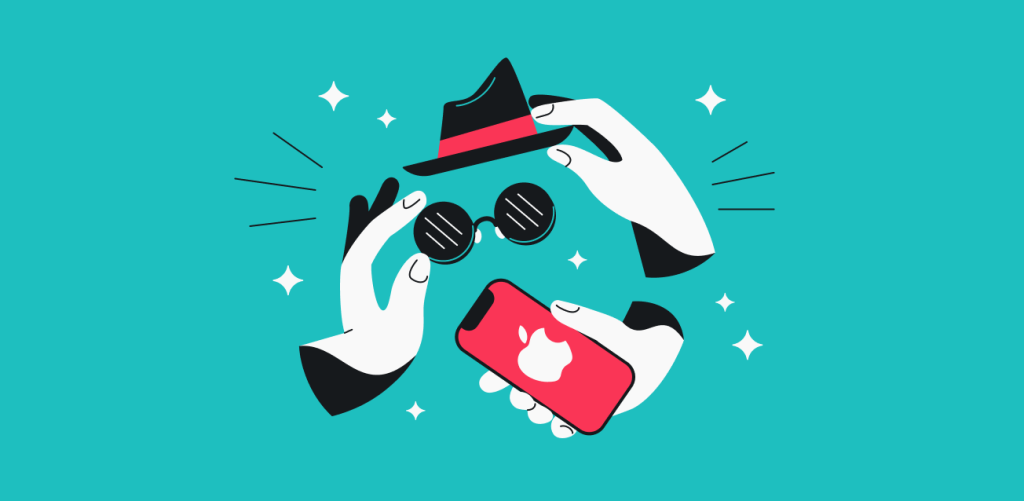
The iPad’s versatility makes it the go-to device for many of us, whether for work, gaming, or everyday use. As a result, it handles a lot of sensitive data, such as login credentials, payment details, and emails.
Keeping this in mind, it’s essential to take steps to safeguard your data. One of the best ways to do so is by using a VPN (Virtual Private Network), which makes your online experience more private and secure.
If you’re new to this, let’s first go through what a VPN is and how to set it up on your iPad. Then, we’ll explain why you might need a VPN for your device and how to pick the best one.
Table of contents
What is a VPN on an iPad?
A VPN is an online privacy tool that encrypts your internet traffic and hides your IP (Internet Protocol) to ensure a secure and private connection to the internet.
If you don’t use a VPN on your iPad, your data is vulnerable. Anyone with hacking skills can easily access sensitive information such as passwords, credit card details, and personal messages. With a VPN, on the other hand, this data becomes encrypted. Even if intercepted, snoopers and hackers will only see indecipherable scrambled texts.
Using a VPN also changes your IP address — which contains identifying information like approximate location and ISP (Internet Service Provider) — to that of the VPN server. So, the websites you visit on your iPad only see the VPN server’s IP address, throwing off anyone trying to snoop or track your whereabouts.
How to use a VPN on your iPad
The first thing you need to do to use a VPN on your iPad is set it up. There are two ways to set up a VPN on your iPad — downloading an application or configuring it manually.
Easy VPN app download
Using a VPN app is a simpler method. Here’s what the process looks like with the Surfshark VPN app on your iPad:
- Head to the App Store and search for the Surfshark iOS app.
- Download and install the app.
- Create an account or log in if you already have one.
- Pick your server and connect to it.
You now have a VPN on your iPad and can leave it as is. Alternatively, you can tweak the settings to enable the Auto-Connect feature, activate the Kill Switch, change to servers with static IPs, and more.
Advanced manual VPN configuration
In contrast, a manual VPN setup is more tricky. However, it’s sometimes necessary to overcome VPN bans in regions under authoritarian regimes or as a backup if your VPN app stops working. Here’s how to set up an IKEv2 connection on your iPad with Surfshark:
- Get a Surfshark plan. If you already have an account, log in and navigate to the VPN tab > Manual Setup > Manual.
- Go to the Locations tab. Scroll down to Other Configuration Files and click on the IKEv2 certificate.
- Note your manual connection credentials from the Credential tab under Manual setup. You’ll need them later.
- Open Settings on your iPad and click on Profile Downloaded at the top.
- Install the profile.
- You’ll see a Warning notice about adding the certificate to your iPad. Click Install again when prompted.
- Once installed, you’ll see the green Verified checkmark. Click Done.
- Go to your VPN’s Locations tab and select a server.
- Navigate to Settings > General > VPN & Device Management > VPN.
- Click Add VPN Configuration and fill in the details below:
Type: IKEv2.
Description: your preferred name for the connection.
Server: the hostname of the server you selected.
Remote ID: same as Server.
Local ID: leave it empty.
User Authentication: username.
Username: enter the credentials from step 3.
Password: enter the credentials from step 3.
Proxy: off.
- Click Done.
- Go to Settings > General > VPN.
- Toggle the VPN status switch on for the IKEv2 configuration you just created.
You’re now connected to a VPN on your iPad.
What are the benefits of using a VPN on an iPad?
Using a VPN on your iPad helps to improve privacy, security, and convenience. Here are some of its benefits:
Improved security
A VPN establishes a secure, encrypted communication tunnel between your iPad and the internet. By encrypting all data to and from your device, snoopers and cybercriminals only see gibberish even if they intercept your data. Meanwhile, your sensitive information, such as passwords, payment details, and personal messages remains private.
Many paid VPNs like Surfshark also come with other features to enhance your security further. For instance, Surfshark’s CleanWeb feature works in the background to block intrusive ads and malicious links.
Enhanced privacy
Without a VPN on your iPad, your private information can end up in the hands of your ISP, advertisers, and other third parties. This includes your browsing history, search activities, and even your approximate location. Your data may then be used for surveillance, sold to advertisers for targeted ads, or exploited by fraudsters.
A VPN ensures your data remains private by encrypting your traffic and masking your actual IP address. With all your traffic encrypted, even your most embarrassing search queries are safe from prying eyes. Meanwhile, your real IP address is replaced by the VPN server’s IP.
Some providers even offer features that let you conceal the fact that you’re using a VPN. One example is Surfshark’s obfuscated servers.
Easy website access while abroad
Accessing your regular websites, platforms, and online services can be challenging while overseas, as many require you to be in a specific country. If you’re outside of the country, your access could be restricted.
This restriction may be due to licensing deals, copyright laws, or even regional marketing tactics. Either way, it can be frustrating, especially if you rely on certain websites for work and entertainment or need access to local services.
A VPN solves this by allowing you to connect to a server in your home country, masking your actual IP address with the server’s IP. This way, you can continue visiting your usual websites on your iPad like you’re back home.
Secure public Wi-Fi use
Many of us use our iPads while on the move and regularly connect to public Wi-Fi for the sake of convenience. However, public Wi-Fi networks at hotels, coffee shops, and airports often lack the necessary protection. This may expose your personal data to various attacks like MITM (Man in the Middle), fake hotspots, and cookie theft.
A VPN on your iPad mitigates these risks by encrypting your traffic and creating a secure tunnel between your device and the VPN server. Whether you’re accessing your banking account from your hotel bed, shopping online at a coffee shop, or working on a confidential project at the airport, a VPN ensures that whatever you’re up to online is shielded from prying eyes.
Cheaper online purchases
As a pricing tactic, many online retailers and service providers charge different prices for the same item based on geographical locations. You’ll see this, especially with hotels and airline companies, which tend to offer lower room rates and fares to locals.
A VPN on your iPad can help you sidestep this price discrimination. By concealing your actual IP address, you can hide your physical location if you’re in a region with an unfavorable rate. You can also connect to VPN servers in different markets to find the best rates and deals.
Minimized internet throttling
Your ISP may deliberately slow down your internet (known as throttling) when you’re gaming, downloading large files, or watching video content. Throttling is usually done to manage network traffic or save costs since these activities consume significant bandwidth.
However, if you use a VPN, your traffic is encrypted — preventing your ISP from seeing what you’re doing and, therefore, unable to throttle your connection. Bear in mind, though, that a VPN only helps to avoid selective throttling. It won’t improve your connection speed if your ISP has implemented a network-wide data cap or is slowing down your connection for other reasons.
How to choose the best VPN for your iPad
There are a few essential factors to consider when choosing the best VPN for your iPad. Here are the main ones to pay attention to:
- Encryption: a secure encryption algorithm is a non-negotiable. Look for AES-256 — the current industry standard. A few VPN services, including Surfshark, also offer ChaCha20 encryption for the WireGuard protocol.
- VPN protocol: tunneling protocols are critical to a VPN’s security. Currently, the best options in the industry are OpenVPN, IKEv2, and WireGuard.
- No-logs policy: when you use a VPN, your internet traffic is routed through the provider’s server — meaning it can track your online activities. That’s why opting for a VPN with a strict, independently audited no-logs policy is vital. For instance, Surfshark’s no-logs policy has been verified by the Big Four firm Deloitte.
- RAM-only servers: most paid providers have upgraded their infrastructure to 100% RAM-only servers. When running on RAM, the servers automatically wipe all data upon reboot for better privacy protection.
- Server count and locations: pick a VPN with a large server fleet worldwide. For instance, Surfshark has 4,500+ servers in 100 countries. More servers translate to reduced server load, minimizing the risk of overcrowding issues like slow connection speeds. Meanwhile, more server locations mean you’ll have an easier time finding a server close to your location for faster speeds.
- Additional features: VPN features vary significantly from one provider to another. Keep an eye out for key features like a Kill Switch, double VPN, and obfuscated servers. Some providers also offer additional security features like an ad blocker.
- Compatibility: before committing to a VPN plan, check that it works with iOS. If you intend to use the VPN on more than just your iPad, go for a VPN that allows multiple simultaneous connections. A handful of providers, including Surfshark, even allow unlimited simultaneous connections.
- User interface: choose a VPN with a user-friendly and responsive iPad app. Setup should be straightforward and quick, allowing you to connect to a server within minutes. Meanwhile, navigation should be intuitive, with all the necessary features within reach. No one wants to deal with clunky or complex apps daily.
- Comprehensive support: Check that your provider offers live support so that you can get help fast — even late at night. For example, Surfshark offers 24/7 support via email and live chat. Ideally, the provider should also have an extensive knowledge base that lets you quickly find all necessary information through a simple search.
VPN on iPad: a crucial addition for enhanced security and privacy
Your iPad handles a wealth of sensitive information. Whether you use it for work, leisure, or managing daily life, it’s wise to safeguard your data by using a VPN. The perks extend well beyond security, too. Using a VPN can also help you save money while shopping online, access your regular websites while traveling, and avoid ISP throttling.
Fortunately, setting up a VPN on your iPad is much easier than you think. Just start by getting the right VPN for the job.
FAQ
Does the iPad have a built-in VPN?
No, the iPad doesn’t have a built-in VPN. Although there’s a VPN configuration option in Settings, it’s simply for setting up connections and not for providing a native VPN app. To use a VPN on your iPad, you’ll need to manually configure your own server or install a VPN app like Surfshark.
Does the iPad have a free VPN?
Yes, there are many free VPNs available for iPads. However, running a VPN service incurs costs. So, if a provider isn’t charging you through a subscription plan, there’s a high chance it’s funding its operations through other means, like tracking and selling your data to third-party buyers. Free VPN services also often suffer from poor security, limited server options, data caps, and slow speeds.
Should you have a VPN turned on on your iPad?
Yes, you should have your iPad’s VPN turned on. A VPN encrypts your iOS device’s incoming and outgoing data to ensure it’s indecipherable to prying eyes. It also conceals your actual IP address for greater privacy.
Do I need a VPN with Apple products?
Yes, you need a VPN with Apple products. Just like with other brands, using a VPN on your Apple devices helps ensure a safer and more private online experience by encrypting your internet traffic and masking your IP address.


